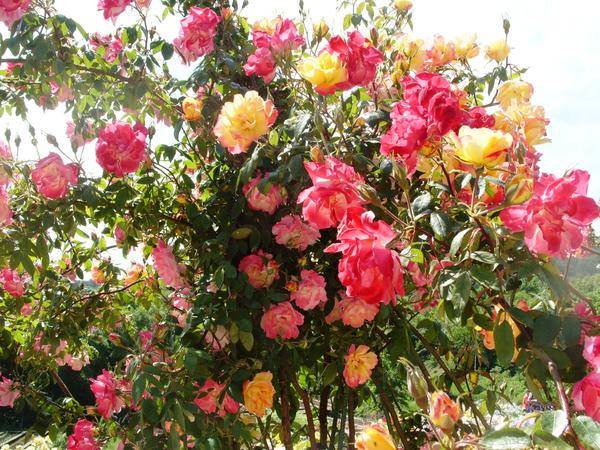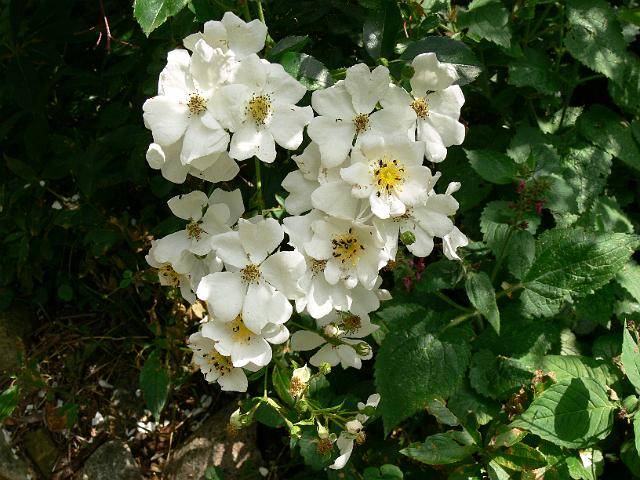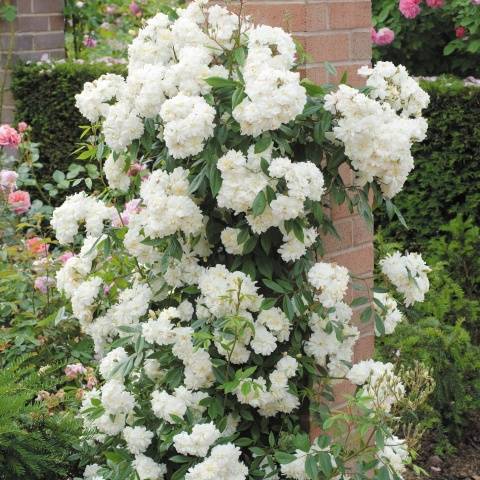Content
The rose is the unsurpassed queen of flowers, remaining a symbol of greatness and beauty for centuries. She is the subject of worship and fiery love. There are probably so many legends about no other flower; it is sung by poets and immortalized by artists on their canvases. We also love roses, because with all their sophistication they are able to bloom all summer and are not particularly difficult to care for even for a novice amateur gardener. True, there are content rules that are best not to be violated. But even if we treat ourselves negligently, the rose will not die immediately; it will send us distress signals for a long time, and when we respond to them, it will quickly recover. Climbing roses are worthy representatives of their species - they are enchantingly beautiful, respond gratefully to good care and will decorate any area with their presence.
A little about the classification of roses
Roses are loved by amateur gardeners, landscape designers and residents of megacities, who enjoy admiring them in city parks, on TV or computer screens, in lush fragrant bouquets.Breeders from all countries love these flowers. Through their efforts, so many varieties have been created that it is impossible to count - from 25 to 50 thousand.
Garden classification of roses has already been discussed in one of our previous articles.
It is constantly changing, since it is not based on the species affiliation of this or that variety - this is simply impossible due to centuries-old selection, repeated inter- and intraspecific crossing. Most roses today simply cannot be traced back to their wild ancestor - one of the 400 species of wild rose hips.
Therefore, stable garden characteristics - biological and decorative characteristics of varieties - were taken as the basis for the classification of roses. Nowadays it is customary to divide roses according to their use in design. The classification constantly undergoes minor changes with the advent of new varieties - breeders do not adhere to boundaries, they simply create a beautiful flower and do not care that it does not fall into any of the groups.
On a global scale, all roses are divided into three huge sectors:
- Species Roses – wild (botanical) species;
- Old Garden Roses are old garden roses from before 1867, preserved without modification. This year is remarkable because the first hybrid tea rose “La France” appeared, which marked the beginning of the history of modern roses. The varieties of the old selection are much inferior in variety and decorativeness to modern roses, but they are all beautiful and deserve special treatment.
- Modern Roses are modern garden roses that appeared after 1867.
As you can see, when we talk about roses by modern varieties, we mean even those that appeared a century and a half ago.
Climbing and climbing roses
Today, both climbing and climbing roses are classified as climbing roses.Strictly speaking, climbing roses do not exist in nature - not a single type of rose hips or variety of roses is capable of climbing. They can only cling to a support with their spines, but to do this, someone must direct the shoots and fix their position.
A large group of climbing roses is divided into two subgroups: large-flowered and small-flowered roses, which differ from each other in external characteristics.
Small-flowered climbing roses
These are exactly the plants that are commonly called climbing roses. Their shoots are flexible, long, arching or creeping, and necessarily need support. Most often they grow up to 5 meters, but there are varieties with more elongated or relatively short vines. Climbing roses most often have huge racemose inflorescences, consisting of small flowers, 2-3 cm in diameter, that do not have a very strong aroma. If the plant has overwintered well, its shoots during flowering are completely hidden under the flowering clusters.
Their disadvantage is that the majority of varieties bloom once a season, however, profusely and for a long time - up to 6-7 weeks. Modern selection of climbing roses is moving towards creating re-blooming varieties, increasing the size of the glass and enhancing the aroma. Ramblers also belong to this group - most often they do not have such long lashes, but their flowers are much larger.
A distinctive feature of a small-flowered or climbing rose is that it blooms on last year’s thin shoots that have overwintered. This makes it difficult to grow in northern regions. The plant overwinters well, but the thin, tender shoots often freeze slightly, and although new ones grow very quickly, flowering turns out to be defective, and sometimes does not occur at all.But if a climbing rose is well covered, its lush beauty will easily outshine its friends with larger flowers.
Large-flowered climbing roses
Very beautiful, large-flowered roses that bloom all summer have powerful thick shoots, sometimes growing up to 4 meters in length. Their flowers, collected in a few loose inflorescences, are large in size. Flowering occurs on this year's shoots, therefore, last year's frozen branches have absolutely no effect on the appearance of buds. Since the growth of the stems of this subgroup of roses is very intense, even a thoroughly frozen plant will grow a new shoot of 1.0-1.5 m within a season and bloom.
Climbing roses, whose shoots do not exceed 1.5-2.0 meters in length, usually do not require support; they can be grown as a spreading bush or hedge. But this does not mean that they cannot be tied up or supported - it will simply be somewhat more difficult to do this than with climbing roses.
Details about climbing roses we talked about in our article.
Predecessors of climbing roses
The origin of climbing varieties is associated with two wild species - Multiflora and Rosehip Vikhura.
Multiflora
Rosehip multiflora or multiflora is native to Japan, Korea, and the island of Taiwan. It has long flexible shoots up to 3 meters long and numerous white or pink flowers about 2 cm in diameter with a faint cinnamon scent. Once in Europe, this rose hip was enthusiastically received, and is still found in parks and large areas. It is often used to create hedges. It is distinguished by lush, abundant flowering throughout the month.
Rosehip Vikhura
This rose hip came to Europe from China, Korea, Japan, and the Philippines.In its homeland it forms picturesque bush thickets. The outstretched bushes can reach almost two meters in height, but almost 6 in width. They are quite large for a rose hip. white or pink fragrant flowers - 1.5-3.0 cm in diameter.
Formation of climbing roses
Another article will tell you in detail about the formation of climbing and climbing roses. We note that climbing varieties definitely need support, since their selection was carried out in such a way that their shoots were as long as possible, flexible and easy to tie up. Only some varieties have powerful, not too long shoots. They were not classified into another group only because they bloom, like all climbing roses, on last year’s branches.
Most often, climbing varieties are grown in the form of a fan - the main and skeletal shoots are placed horizontally or in a fan. They are tied to a strong support, braided in plastic with wire.
Thin vertical branches will grow from horizontally located thick shoots, on which flowering will occur.
It is climbing roses that are planted next to the arches. Watch a video about planting options for climbing varieties:
It is important to remember that you need to form climbing varieties right away - they grow very quickly, if you miss at least a year, it will be very difficult to put the shoots in order.
Varieties of climbing roses
No one argues that all flowers are beautiful, but the topic of our article is climbing roses.Photos of varieties will help you appreciate their beauty, and perhaps even choose a new plant for your garden.
Excelsa
One of the most famous climbing varieties in the world. Fast-growing lashes reach a length of 4 meters. Double flowers with a diameter of 3 to 5 cm have a slightly sweet aroma and are colored crimson. The variety is frost-hardy and moderately resistant to diseases.
Super Excelsa
An improved version of the Excelsa variety. It is characterized by repeated flowering and greater resistance to diseases. The variety can be called super winter-hardy, although it also grows well in hot climates. The bush is less vigorous than the original variety - its shoots grow up to 1.5-2.0 meters. The flowers are crimson, 3-4 cm in diameter, collected in clusters of 5-10 pieces, with a faint aroma.
Dorothy Dennison
The world's most famous climbing variety. Shoots with sparse thorns and large leaves grow up to 3.5 m. Semi-double flowers with a diameter of 4.0-4.5 cm are pale pink in color, collected in 7-30 pieces in inflorescences. The variety is winter-hardy.
Amethyst
A once-blooming climbing variety. Shoots equipped with large thorns reach 3 meters in length. Double flowers, collected in clusters of up to 40 pieces, have a pink-violet color, a weak aroma and a diameter of up to 5 cm. A winter-hardy variety.
American Pilar
This variety is not just popular - it has been mega-popular all over the world since its inception. It blooms once, but blooms very late, when other roses have long passed their flowering peak. Raspberry spherical non-double glasses of bright pink color with a light center and large golden stamens. The vines grow up to 3-4 m in length, are equipped with large red thorns, the leaves turn red in the fall and decorate the garden for a long time. Looks best on a trellis.
White Flight
It blooms once, but the flowers of this variety are of extraordinary beauty. The buds are pink, but when they open, the flowers are pure white in color; as they age, they acquire a greenish color. The size of a semi-double flower is 3-4 cm, the petals have wavy edges. Shoots grow up to 3-4 m. It has average resistance to diseases.
Blue Magenta
An absolutely delightful variety with velvety purple-violet densely double flowers up to 7 cm in diameter. It blooms once, the length of almost thornless shoots reaches 3-4 meters. Average resistance to diseases, frost resistance is good.
Snow Goose
Repeat flowering variety with small white flowers, with a diameter of about 4 cm. Densely double flowers have petals of varying lengths, resemble daisies and are collected in tassels of 5-20 pieces. The little thorny lashes reach a length of 3 meters. The variety is very frost-hardy and disease resistant. In hot climates it blooms continuously, and shoots can grow up to 5 m.
Bobby Jame
One of the largest and most profusely flowering white varieties. Prickly shoots grow up to 5-8 m in length. White, creamy, semi-double flowers with a strong aroma are collected in large clusters. It blooms once, but for a very long time, and the bush is almost completely covered with flowers. Has good frost resistance.
Marvern Hills
A repeat-blooming variety, reaching a height of at least 3.5 m. Flexible thin shoots are not suitable for growing as a single plant, but they will look great on a trellis. The flowers are about 5 cm in diameter, medium double, fragrant, pale yellow in color. During flowering, the bush is almost completely covered with flower clusters. Disease resistance and winter hardiness are ideal.
Conclusion
As you can see, climbing roses are varied and very attractive.Everyone can find a variety to their liking. Moreover, in vertical gardening, not a single flower can compete with them.
































